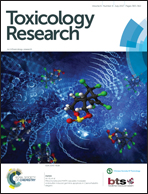Differential gene responses in the embryo of the green mussel Perna viridis exposed to dichlorodiphenyltrichloroethane (DDT)†
Abstract
The green-lipped mussel, Perna viridis, is considered to be an ideal indicator for marine environmental pollution. Dichlorodiphenyltrichloroethane (DDT), a typical persistent organic pollutant, is extensively distributed in marine environments. However, little is known about the toxic effects of DDT on the embryo of marine animals, particularly in marine bivalves. Using next-generation sequencing technology, we studied P. viridis embryo after DDT stress at the transcriptome level. A total of 99 202 unigenes were obtained based on the 2383 bp of unigene N50. These differentially expressed genes (DEGs) participated in the various molecular pathways of biological effects, including oxidative stress, detoxification, innate immunity and neurobehavioral disease. Quantitative real-time PCR was performed to verify the mRNA expression of several genes identified by differential gene expression (DGE) analysis. The results indicated that DDT was in induced a dose-dependent manner in the embryo of P. viridis, and most genes involved in oxidative stress and detoxification were up-regulated by DDT exposure; however, the immunity-related genes were down-regulated, except the genes involved in phagocytosis. Gene expression changes in embryo from P. viridis provide a preliminary basis to better understand the molecular toxic response mechanisms of embryo to DDT.



 Please wait while we load your content...
Please wait while we load your content...